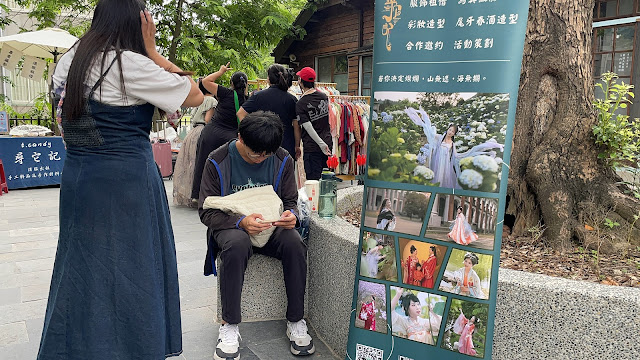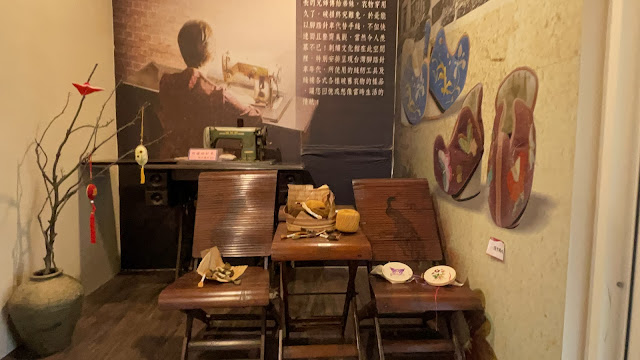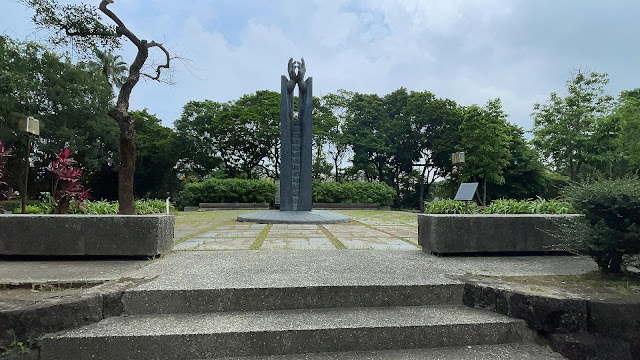Travel date: 2024/06/08
This trip south was filled with the charm of Japanese-era buildings. I tried to find places to see on the Chiayi-Tainan border and stumbled upon Puzi Town. Having lived in Tainan for three years, I had no idea there was such a large area of Japanese buildings nearby. Maybe it was because we rarely visited Chiayi, or I just never checked the small towns around well enough to notice them.
Sometimes I feel that most tourist spots in Taiwan are related to the Japanese era, with fewer remaining from the Qing Dynasty, as much older structures have been destroyed over time. I never actually thought of traveling to Japan, but I really like those wooden buildings, I feel that it would be a dream future house.
When we arrived at the Japanese dormitories area, there was an event preparing to start later on - a market organized for the Dragon Boat Festival. I'm not sure how busy it is without the market, but I think it would be much quieter as it doesn't seem to have many shops around. Compared to the Japanese dormitories in Chiayi City, these are much less known.
Our next stop was Tainan's Houbi District. We once again visited Jingliao Old Street. We came here once during COVID-19, and it was rainy that day. At that time, I thought it was a boring and not well-known area, but today's feeling was so different! It's actually filled with visitors, and there were shops open, food, and drink - totally different from a few years ago. Traveling during COVID-19 wasn't fun at all.
Even though the weather was supposed to be rainy, we actually got plenty of sunshine. It was noon and pretty hot. It's been two years since moving out of Tainan, and the north feels a lot cooler, so I also had a bit of trouble accepting the heat. We visited the old street, an old drug store, a Dutch well, a rice mill, and later on stopped at an elementary school that had two unique buildings left from Japanese times. We also drove to another place, but the octagonal storage was closed, and the dormitory only opens for students during school time, so there wasn't much to see.
Check out Japanese-era relics in Houbi in my other post [LINK].
Check out Qing-Dynasty relics in Houbi in my other post [LINK].
Puzi City (朴子市)
Formerly known as Pho-a-kha (樸仔脚), Puzi City (朴子市) is a county-administered city in Chiayi County, Taiwan. In 1920, during Japanese rule, it was renamed Puzi Street (朴子街) and governed under Tōseki District, Tainan Prefecture. This captivating destination, steeped in history and cultural heritage, has evolved from a modest settlement into a central hub in the coastal region.
Puzi City, known in Taiwanese as Phoh-tsú-tshī, is located in western Chiayi County and has grown around the temple dedicated to Mazu, fostering its development.
In 1945, the area was reorganized as Puzi Town in Tainan County. It was incorporated into Chiayi County in 1950, and in 1992, following the relocation of the Chiayi County Council, it was upgraded to a county-administered city. The establishment of the Chiayi HSR station and BRT has increased commuter traffic to Chiayi City.
The settlement was recorded in Dutch documents as "Causieu". During the Qing Dynasty, it was renamed Puzi Jiao. The area was initially sparsely populated with a few farmhouses. In 1682, a statue of Mazu was brought from Meizhou and enshrined in Puzi, leading to the establishment of the Peitian Temple. The town developed around this temple, which remains central to the city's identity.
Key historical events and developments:
- 1898: Establishment of Puzi language school
- 1901: Puzi Street uprising led by Huang Maosong
- 1911: Puzi Line of the Suantou sugar factory railway opened
- 1934: Construction of the Puzi Water Tower, a significant landmark
- 1945: Post-WWII reorganization into Tainan County's Puzi Town
- 1950: Integration into Chiayi County
- 1992: Upgraded to a county-administered city
Puzi Water Tower (朴子水道配水塔)
The Puzi Water Distribution Tower, also known as the "Puzi Water Tower" or "Shuidaotou," is a public water supply facility located in Puzi City. It was established in 1933 during the Japanese occupation under the administration of Huang Madian, the then mayor of Puzi Street, and completed in 1936. This structure played a crucial role in improving the drinking water hygiene for Puzi Street residents at the time. Due to its historical and cultural significance, it was designated as a cultural asset in 2014.
Initially registered as a historical building on September 7, 2006, it was later designated as a county-designated historic site on November 4, 2014. Today, it stands as an important landscape landmark in Puzi City.
Located at the east end of Puzi Market and south of Niuchou Creek (now Puzi Creek), the water distribution tower was built to address the poor public health conditions and lack of an established epidemic prevention system during the Japanese colonial period. Residents primarily relied on wells for water. In 1933, Huang Madian began constructing a facility to purify and distribute water from sewers. The tower was one of several structures, including intake wells, sand slide wells, raw water pump wells, pump chambers, distribution wells, sedimentation tanks, filtration tanks, and more. The entire project was completed in 1936.
However, due to sedimentation and pollution, groundwater wells were later used. In 1974, after the merger with the Taiwan Provincial Water Supply Company, water was sourced from the Wushantou Reservoir.
The tower is built in a European style using concrete RC structure. It stands 35 meters high and can hold 450 tons of water. The structure comprises three parts:
- Top: Decorative tower with a hexagonal dome shape.
- Middle: Circular water tank.
- Bottom: RC structure with four ring beams and ten pillars, reinforced with radial mesh columns.
The Puzi Waterway Water Distribution Tower, once the tallest building in Puzi, became a landmark and a significant tourist attraction. It also served as a lookout point accessible via an escalator. Currently, the tower is not open to the public due to structural concerns, including cracks in the columns. Restoration efforts are planned to preserve this historical structure.
Chiayi Shuidaotou Cultural and Creative Settlement (水道頭文創聚落)
Chiayi Shuidaotou Cultural and Creative Settlement located in Puzi City is the first cultural and creative settlement point in Chiayi County. The core building of this settlement is the Shuidaotou, also known as the Puzi Water Distribution Tower. Built in 1936 during the Japanese era, this structure served as a public water supply facility.
Adjacent to the tower is a group of Japanese-style buildings that once served as residences for police officers and teachers during the Japanese era. These buildings now form the Chiayi Shuidaotou Cultural and Creative Settlement, the largest cluster of Japanese-style architecture along the Chiayi coast. Currently managed by the Chiayi County Cultural and Tourism Bureau, the settlement hosts various cultural and creative workshops, exhibitions, and interactive performances.
Hidden in the bustling alleys of Puzi City, the Puzi Waterway Japanese Dormitory District retains a rich Japanese atmosphere. This area includes the old principal's dormitory of Dongshi Junior High School at Shantong Road 14 and extends to numbers 16 and 18, as well as eight other dormitories along Zhongzheng Road. These buildings served as police and teacher residences during the Japanese era.
The area has been renovated and planned to enhance its historical and cultural value.
The area is filled with Japanese-style features such as stone lanterns and traditional Japanese gardens. The dormitory area now hosts various cultural and creative stores offering handmade food, crafts, and beverages. It's an ideal spot for those who appreciate quiet Japanese-style environments, perfect for a peaceful date or visit.
The settlement is open to visitors from Wednesday to Sunday, 11 AM to 5 PM, and offers various cultural and creative experiences. The space includes a permanent exhibition area and public interaction zones.
The renovation project took nearly four years and cost 75 million yuan to refurbish the first batch of Japanese-style dormitories. It successfully completed investment promotion and officially opened to the public in February 2018. The types of stores that have established themselves in the Shuidaotou Cultural and Creative Cluster include pottery, life crafts, local culture and history, coffee, and light food establishments.
Chiayi County Culture and Tourism Director Xu Youren noted that following the renovation of the first batch of Japanese-style dormitories, the county government secured an additional 20 million yuan from the Tourism Bureau of the Ministry of Transportation. This funding is intended to beautify the surrounding area of the dormitories, enhance the benefits of the cluster, and promote Puzi's transformation. The aim is to make the atmosphere of the Japanese living space a memorable part of modern life.
Puzi Embroidery Cultural Hall (朴子市刺繡文化館)
In the early days, Puzi City in Chiayi County was a major hub for the embroidery industry. The prosperity of that time is reflected in the large number of embroidered products exported from Puzi City, including Eight Immortals embroidery, door curtains, pillowcases, bed sheets, glove puppet costumes, Taiwanese opera costumes, bridal trousseaus, and more. These products were sold all over Taiwan. To preserve and promote this outstanding local cultural feature, the Puzi City Office has been dedicated to the development of embroidery since 2002. They not only established the Chiayi County Embroidery Culture Association and offered embroidery training courses but also built the Embroidery Culture Museum with the support of the Ministry of Culture.
The Embroidery Culture Museum was originally the office space of the local ship crew and was repurposed from the old wooden Japanese dormitory buildings, giving it a historical charm that aligns with the spirit of embroidery culture. The museum documents the heyday of the embroidery industry in Puzi City and houses many meticulously crafted, breathtaking embroidery works. Through interactive learning about the entire industry, the Embroidery Culture Museum revitalizes the rich local culture, integrates community activities, promotes cultural tourism, and has become an attractive tourist destination.
Dongshi Shrine (東石神社)
Dongshi Shrine was a shrine located on Puzi Street, Dongshi County, Tainan Prefecture during the Japanese colonial period in Taiwan. It was established in 1936. The original site is now Puzi Art Park in Puzi City, Chiayi County. The shrine remnants such as the torii gate, komainu and shrine of Dongshi Shrine were listed as Chiayi County historical buildings on December 17, 2019.
Dongshi Shrine is a shrine guarding Dongshi County. It's located on the east side of Puzi City. The west side of the shrine is adjacent to the water source of Puzi Waterway. It started construction in January 1936 and was completed with a town hall ceremony on September 10 of the same year. On July 28, 1944, Toishi Shrine was upgraded to a rural shrine.
After World War II, the Shrine was turned into a coastal patrol camp and the shrine hall was demolished. After the withdrawal of the national army in 1987, it was reorganized into Puzi Art Park.
In Japanese named Tōseki Jinjya/とうせきじんじゃ. The officiating deity was Amaterasu, the three pioneer gods (Okuni Tamomei, Oki Nomei, and Shaoyan Mingmei), and Prince Nohisa of Kitashirakawa Palace.
Address:
1. Chiayi Shuidaotou Cultural and Creative Settlement: 613嘉義縣朴子市中正路17號
2. Puzi Embroidery Cultural Hall: 613嘉義縣朴子市文明路10號
3. Donshi Shrine:613嘉義縣朴子市東石神社遺址



























0 komentarze:
Post a Comment